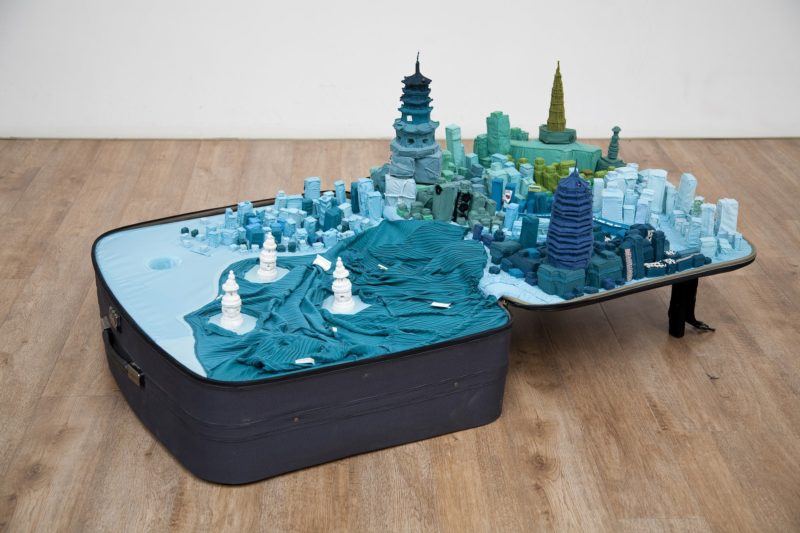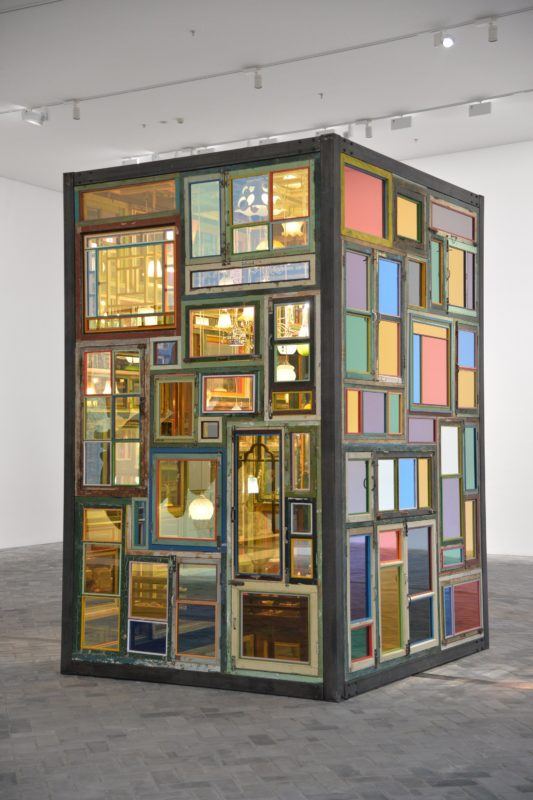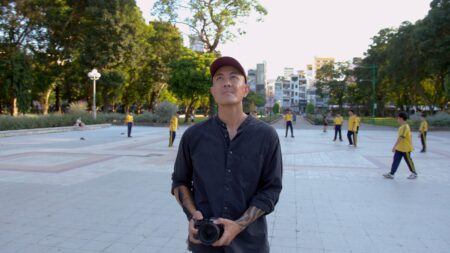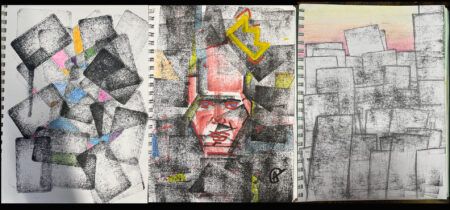Teaching with Contemporary Art
Teaching in a Pandemic

Yin Xiuzhen. “Portable City: Hangzhou,” 2011. Suitcase, clothes, magnifying glass, map, sound element; 11 × 59 13/16 × 34 5/8 in. (28 × 152 × 88 cm). © Yin Xiuzhen. Courtesy Pace Gallery.
I remember being a new teacher, back in 1990. I didn’t know where things were in the school building. I was unfamiliar with many policies and protocols. I didn’t have the bag of tricks my veteran colleagues had. My mentor was a retired teacher who came to school on Mondays and stood in the doorway of my classroom for a while (he never actually walked into my room), and then, after I reassured him that things were going great in class, he would stroll down the hall to the teacher’s lounge and reminisce for hours about old times. But my teaching experience was not going great; I remember feeling like I was alone and had to invent practically everything.
This pandemic reminds me of that time. We’re all new teachers again. Whether one is teaching remotely, using a hybrid system, or some other cocktail combo of classes, this is about starting again from square one. I want to believe that something good will come out of this, but right now, as we embark on a new school year unlike any other, I am a bit fearful.

Nicole Ciaravella, “Swimming.” Nyack High School, NY.
The last few weeks of summer included spending many hours every day in Zoom meetings, getting ready for the school year. (In addition to my work with Art21, I teach in and serve as the department chair for visual arts for the Nyack Public Schools, just north of New York City.) I have sat in virtual meetings about scheduling, safety protocols, safety equipment, hybrid learning plans, curriculum, and much more. We even welcomed our new high school freshmen via Zoom recently.
I’m usually a geek for getting back to school at the end of summer. When people ask if I am ready for the students, I often reply, “I hope they’re ready for me!” I have always prided myself on being especially prepared, organized, and excited for the new academic season.
It’s a very different story this year.
Instead of worrying about classroom management and students who may show difficulty behaving themselves in certain scenarios, I am worried about making sure my students find our Zoom sessions interesting and about maintaining a level of motivation without being in the same room with them. I believe that body language and gestures are important components of teaching, and I thrive while performing in the classroom. In this regard, remote learning presents a huge challenge.
This school year is one of reinvention, reimagining, revising, and relearning. We’re all new teachers again. As most of us know quite well, a curriculum doesn’t just disappear due to a pandemic, and unless we make significant changes to our approaches to teaching, we simply will not “survive” until things go back to some sort of normal.
Lately I’m considering a few important questions in my own practice:
How can we continue to teach with big, engaging questions and emphasize teachers’ roles in the investigation of questions about making art and participating as citizens in society? This is an important time, and it’s crucial for students to understand this. Using an example from an Art21-featured artist: when Mary Mattingly creates different projects that allow one to explore how we might survive in a dystopian world, she is modeling how we must think broadly about things, like our rapidly changing environment.

Production still from that Art21 New York Close Up film, “Mary Mattingly Owns Up.” © Art21, Inc. 2013.
How can we reconsider our use of materials, in the way that many contemporary artists have questioned what constitutes an art material? With students working at home, not in an art classroom with basic supplies, this is important to consider. For example, when the Season 10 artists Guan Xiao, Song Dong, and Yin Xiuzhen juxtapose familiar elements from everyday life in their work, they are asking us to reconsider not only what sculpture can be but also our relationship to the materials before us.

Song Dong. “Same Bed Different Dreams No. 3,” 2018. Steel, wooden windows/doors/beds, mirror, coated glass, lights, daily necessities, porcelain; 100 3/16 × 88 3/8 × 142 1/8 in. (254.5 × 224.5 × 361 cm). © Song Dong. Courtesy Pace Gallery.
And what does emphasizing the artmaking process look like in a context of remote instruction, as well as in various other contexts where we might find ourselves, as educators? How can we help students better understand that what we learn along the way is just as important as the aesthetic outcome of a final project? Artists such as Olafur Eliasson use the knowledge gained from the processes of artmaking and collaboration to influence not only a current project but also subsequent projects and their creation.
Whether one is teaching remotely or in person, the core questions we want our students to engage with remain consistent. At this point in my teaching, I remind myself often that the big picture doesn’t change simply because the teaching platform does. Contemporary art educators find ways to weave these important questions, and many others, into a variety of contexts, in order to inspire those “a-ha!” moments as well as to prepare for the moment when we see our students in person again.



